50 guitars that changed the world
A perfect union of form and function, guitars have the power to change the course of music and even history itself. Here, we present the most influential guitars of our time
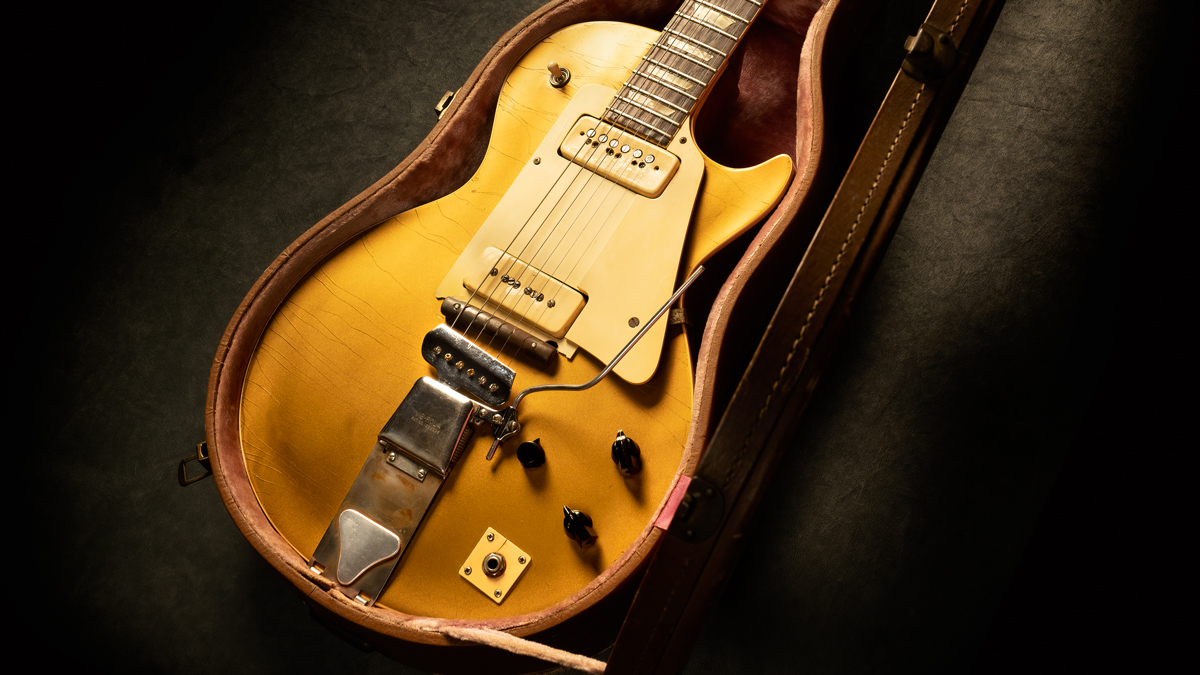
There’s a good story told about Chet Atkins. One day, someone who had stopped to listen to him play said, “Man, that guitar sure sounds good!” According to the tale, Chet put the guitar down on a chair then said to its admirer: “How good does it sound now?”
His point, of course, is that guitars are just lumps of metal and wood until a player brings them to life. As enjoyable as it is to pore over the technical evolution of famous guitar models – and we do plenty of that – instruments can’t be truly historic until they are used to make influential music. Pioneering musicians, in their turn, set the agenda for the next generation of instrument design – and so the wheel of history turns.
In that sense, the player and the instrument itself are forever entangled, indivisible. That’s why, when we decided to explore which guitars have had the most impact on history, we realised it must include not just classic models (though sometimes it is enough to simply invent something first to make history), but also identify specific iconic instruments that represented a fleeting moment when the world stopped to listen to a new sound and, in so doing, was changed forever.
For example, it’s hard to imagine Peggy Sue without Buddy Holly’s ’55 Strat. By the same token, the Strat itself might never have become an icon of rock ’n’ roll without Buddy Holly.
The following article therefore represents an attempt to trace the most crucial pairings of artist and instrument, each of which tilted history on its axis just a little and set music rolling down a new path. They also contain lesser-known contributions to the evolution of the instrument that were made by guitar designs that, without setting the world alight, nonetheless changed our perception of what the guitar could and should be.
Our guide in this endeavour is celebrated guitar historian Tony Bacon, who compiled the following list of 50 extraordinary instruments that mark a watershed in the history of the instrument, both musically and technically. We hope you gain fresh insight into the evolution of guitar as you join us on the journey.
1. c.1590 Unknown Maker five-course guitar

This very early guitar is a rare survivor, thanks partly to its prized workmanship. It has five courses, a format that developed around the mid-16th century from the earlier ‘treble’ four-course instrument. A course can be a single, double (as here), or even triple string. Inevitably, this guitar has been restored: as such, the top has been replaced and the neck rebuilt and cut down, although a beautiful central ‘rose’ in the soundhole is original.
Get The Pick Newsletter
All the latest guitar news, interviews, lessons, reviews, deals and more, direct to your inbox!
2. c. 1804 Pagés six-course guitar

Around the end of the 18th century, makers began to move from five to six courses, and with the addition of the low-E course, tuning began to settle at EADGBE. A further change to six single strings, at first in Italy and France, resulted in something closer to a modern flat-top. This six-course guitar was made in Cadiz, Spain, by Josef Pagés with 12 full-size metal frets and shorter ‘treble’ frets on the body.
3. 1888 Torres classical guitar
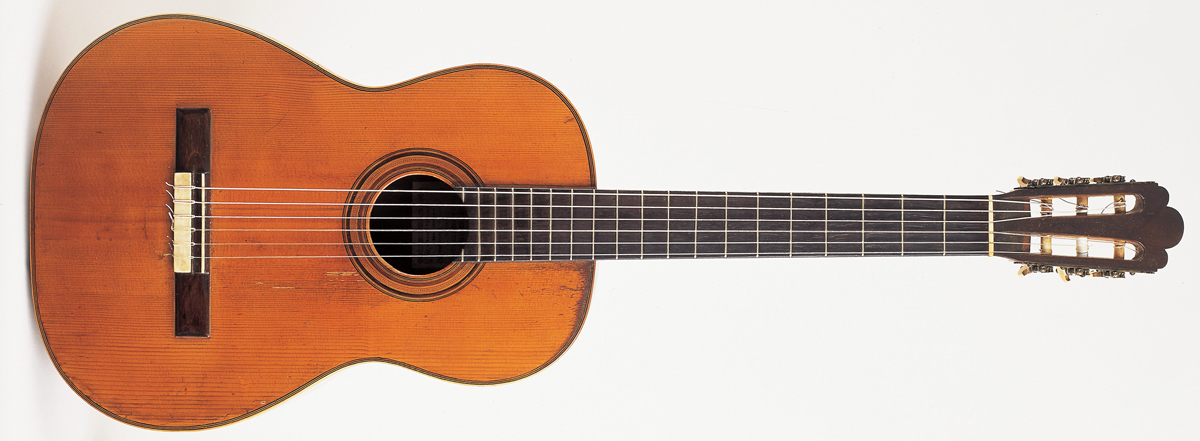
In the 19th century, the classical guitar began to take shape, and the maker most responsible for this evolution was a Spaniard named Antonio de Torres, active from the 1850s to the 1890s. He determined the guitar’s top as key to its sound and developed a fan-strutting pattern for the underside. Torres domed the lower bout, shifted the bridge further into the body, and used relatively thin woods. His ideas for an integrated guitar were widely adopted in Spain and abroad.
4. Maybelle Carter’s 1928 Gibson L-5
Lloyd Loar’s greatest contribution at Gibson was the Master Series L-5 guitar, introduced in 1922. It had violin-style f-holes instead of a regular soundhole and established many of the ideas for the modern archtop acoustic.
Maybelle Carter regularly played an L-5, setting templates for much of country, bluegrass and folk guitar. Her style neatly blurred the lines between melody and rhythm, always supporting the singer and providing crisp leads where needed.
5. Joan Baez’s 1929 Martin 0-45
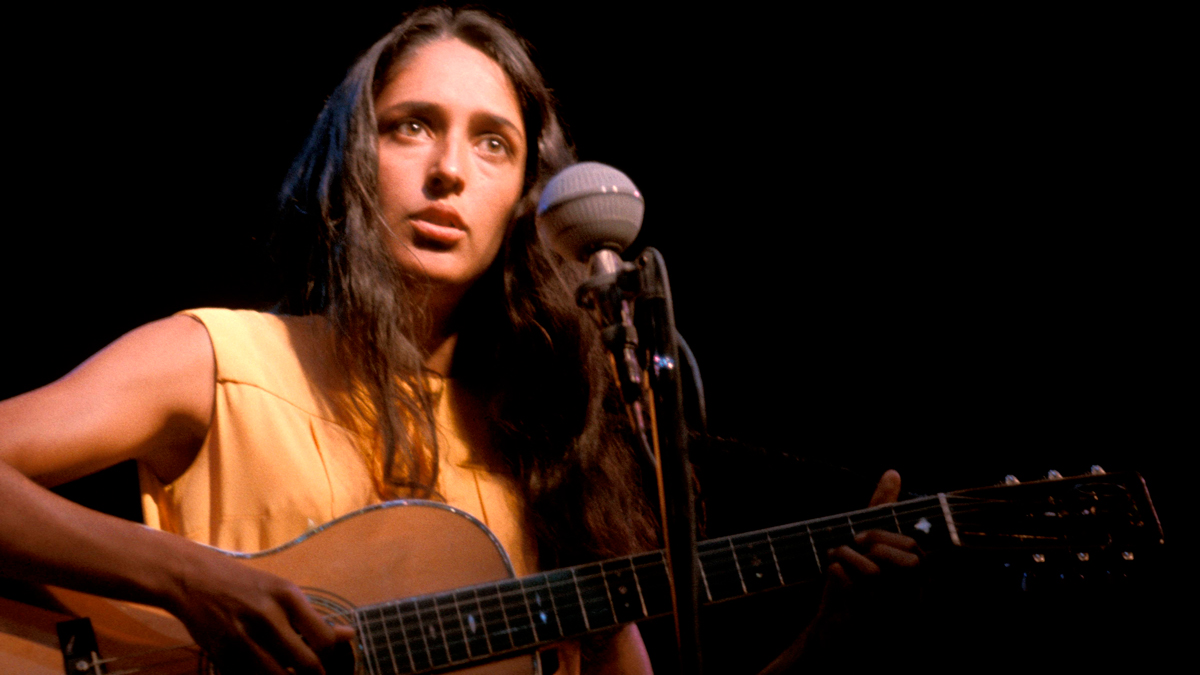
Following Martin’s innovative X-bracing, in the early decades of the 20th century, it came to define the modern flat-top guitar, and by 1928 was bracing all models for steel strings.
Joan Baez acquired this ’29 0-45 in 1959 for $200 and has played it (or a replica) ever since. Martin’s Size 0 was a relatively large ‘parlour guitar’, a little over 13 inches wide, and 45 was the fanciest Style with distinctive abalone inlay.
6. Lead Belly’s c.1930 Stella 12-string
The skiffle, folk and blues boom of the '50s and '60s brought a new popularity to the 12-string, its sizable singer-supporting sound coming from strings arranged in six pairs tuned in octaves and unison doubling.
Records by the country bluesman Lead Belly, who mostly played a Stella 12 like this one, were a big influence. The Stella brand was used at the time by the Oscar Schmidt instrument company of New Jersey.
7. 1932 Rickenbacker Frying Pan prototype

This maple lap-steel experiment was the first guitar to feature an electro-magnetic pickup, which makes it effectively the basis for the majority of electric guitars that have followed since.
George Beauchamp was a partner in Ro-Pat-In – soon renamed the Electro String Instrument Company – along with Adolph Rickenbacker and Paul Barth, and he devised the instrument’s ‘horseshoe’ pickup. Electro began selling the cast aluminium production-version A-25 lap steel later in 1932.
8. Charlie Christian’s c.1937 Gibson ES-150

This was Gibson’s first Spanish electric guitar, launched in 1936. After World War II, electrics would become an important part of Gibson’s revived business, but the ES-150 marked an important first step in that direction.
Charlie Christian played early Gibson electrics, including a 150, with Benny Goodman, and his pioneering work proved that amplified guitars could work as soloing instruments in jazz and elsewhere. He died just 25 years old in 1942.
9. Mark Knopfler’s 1937 National Style 0
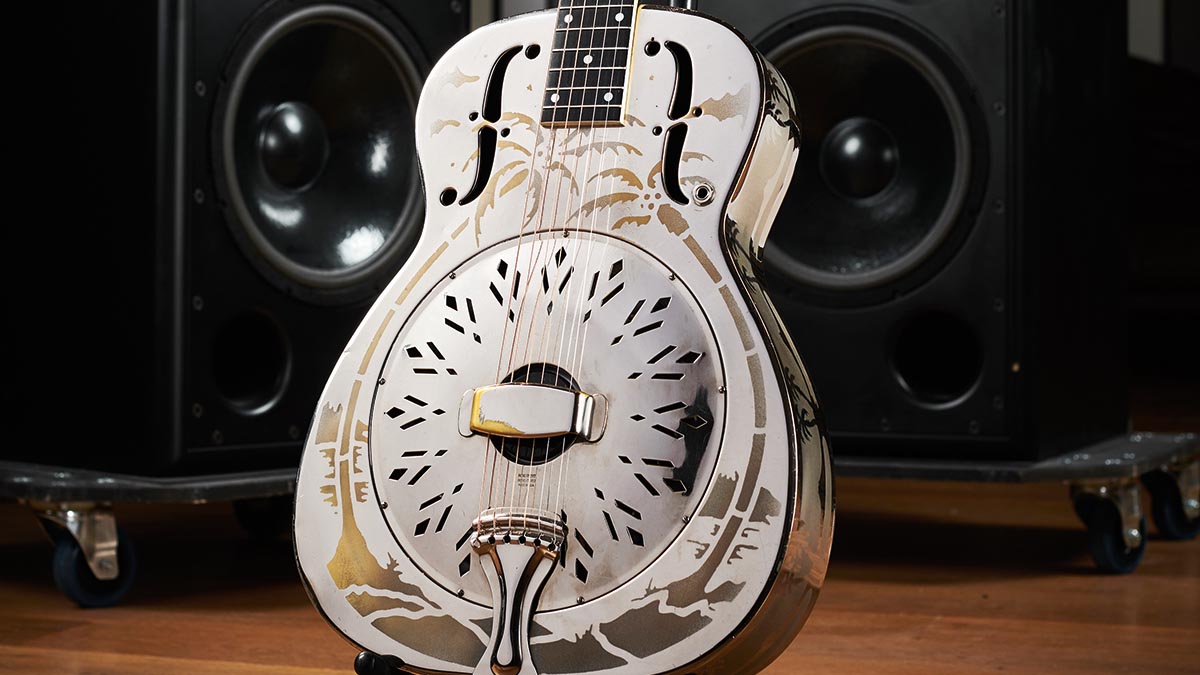
When Mark Knopfler’s National guitar, shining like the Mississippi Delta, starred on the cover of Dire Straits’ 1985 album, Brothers In Arms, it sparked a revival of interest in resonator instruments.
Visible on Knopfler’s guitar are the vivid decorations National sandblasted onto the bodies of some of its models. John Dopyera and George Beauchamp at National developed a system with aluminium resonators suspended inside a guitar’s metal body to produce extra volume and a distinctive sound.
10. 1939 National Sonora
This was probably the first two-pickup electric guitar. Until National in California introduced this model, the electric lap steel and Spanish electrics that began to trickle out from some makers during the 30s all had single pickups, usually at the bridge (although Gibson, for example, put its Spanish guitar pickup at the neck).
The obscure Sonora model paved the way for two, three or more pickups – but there remained an appeal to the simplicity of one.
11. 1948 Bigsby Merle Travis
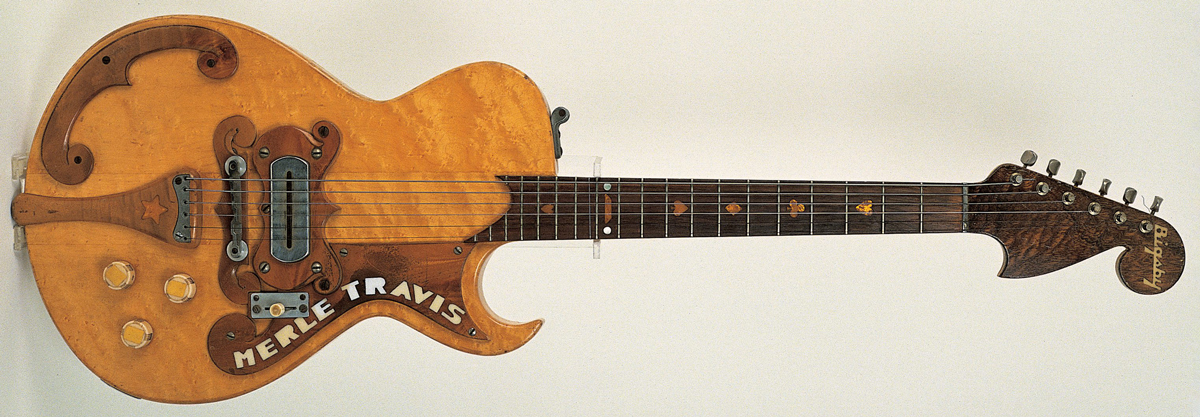
This remarkably influential guitar looks closer to our idea of a modern solid electric guitar than anything that had gone before.
Merle Travis was a fine country guitarist, Paul Bigsby a mechanic and woodworker who fixed motorcycles and built custom pedal-steel guitars. They devised the Bigsby-Travis guitar in California in the late 40s, pre-dating Fender’s first solidbody.
Bigsby – better known for his vibrato, patented four years later – produced some similar guitars but only in small numbers.
12. 1950 Fender Broadcaster

This is the guitar that roused an entire industry to seriously consider the new idea of a modern mass-produced solidbody electric guitar. Gretsch complained about Fender’s original name, Broadcaster, and during 1951 Fender changed it to Telecaster.
The much-copied Tele retained its straightforward, no-nonsense style and playability through the ensuing decades and remains a near-perfect utilitarian design geared for mass production – and for players who continue to recognise the value of elegant simplicity.
13. Les Paul’s 1952 Gibson Les Paul Model
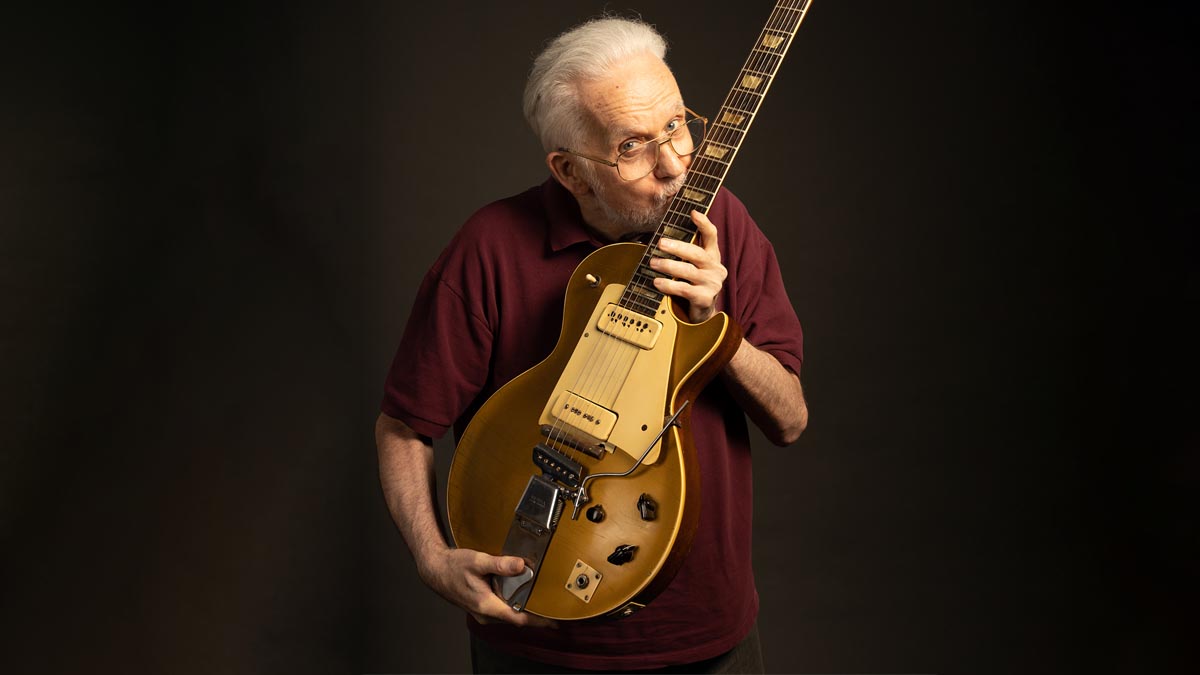
Even a conservative Midwest company such as Gibson did not wait long to react to Fender’s activities in California, and soon the firm was busy designing its own new solidbody.
It was introduced in 1952, reflecting Gibson’s craft heritage in contrast to Fender’s unpretentious approach, and endorsed by America’s most famous guitarist, Les Paul. This guitar, since much restored, was one that Gibson gave to Les Paul himself and which the guitarist used widely in the 50s.
14. Grady Martin’s 1952 Bigsby doubleneck
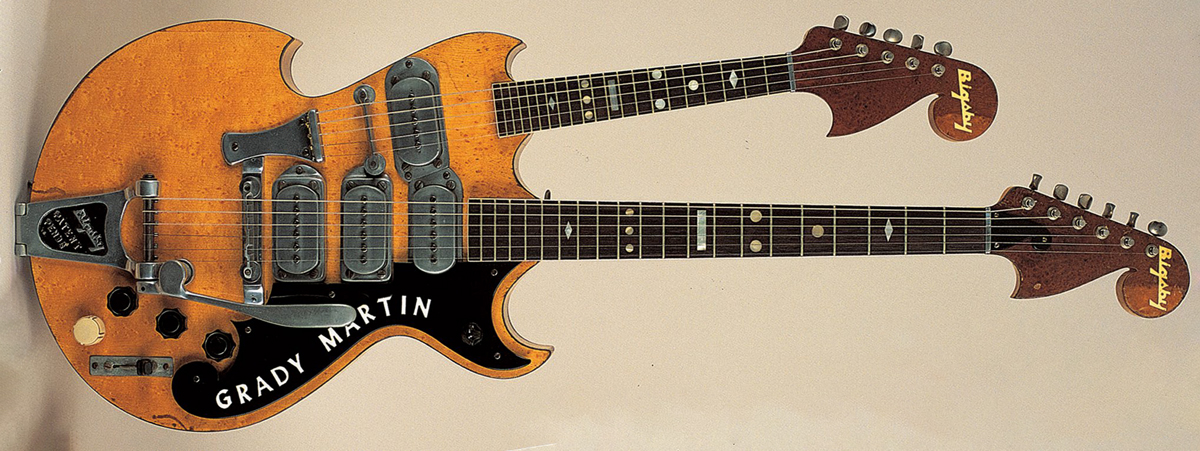
Among the Spanish electrics made by Paul Bigsby was the first solidbody doubleneck guitar, built in 1952 for the busy Nashville studio guitarist Grady Martin. He ordered his Bigsby doubleneck with a regular six-string neck plus a five-string mandolin neck.
For Bigsby, used to making double- and triple-neck steels, the design may have seemed a logical step, but it paved the way for other brave makers and strapping musicians to chance their arm with several necks.
15. Buddy Holly’s c.1955 Fender Stratocaster
Fender’s second solidbody was introduced in 1954. Three years later, in December ’57, American TV provided a boost for the guitar when Buddy Holly strummed a Strat on The Ed Sullivan Show.
Holly had topped the charts with That’ll Be The Day and now had a new 45, Peggy Sue, and his Strat was on the cover of his ’57 album, The “Chirping” Crickets, too. Suddenly, thousands of aspiring guitarists knew the guitar they wanted for Christmas.
16. Chuck Berry’s 1955 Gibson ES-350T
Chuck Berry invented so much about electric guitar playing – including the signature licks that influenced every budding rock ’n’ roller in the '50s and early '60s – that it’s easy to overlook his guitars.
Chuck’s axe of choice in the classic early days was a stylish 350T, which combined a comfortable thinline body with a shorter neck and scale, and the model set the style for many of the electric hollowbodies to come from Gibson as well as other makers.
17. 1955 Stratosphere Twin
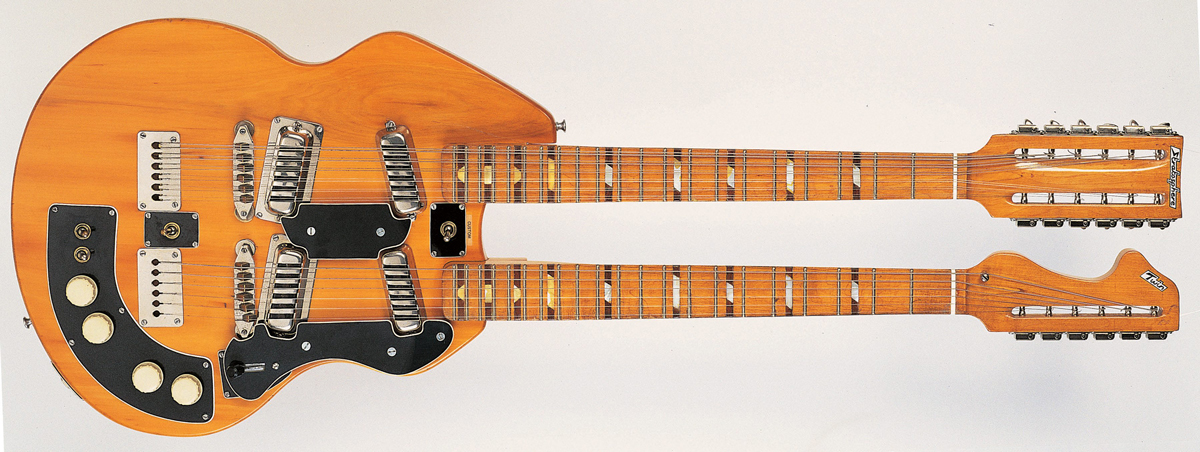
This rare model is the one for which the Missouri-based brothers Russ and Claude Deaver will go down in guitar history because it was the first production doubleneck electric and it incorporated the first 12-string electric.
Their 12-string, also offered as a single-neck model, used an unusual tuning system that required guitarists to reconsider their playing techniques. Chet Atkins used a Twin, as did the West Coast session guitarist Jimmy Bryant, but Stratosphere’s instruments soon faded from the scene.
18. Joni Mitchell’s 1956 Martin D-28
Joni Mitchell learned to play guitar from a Pete Seeger instruction book. She soon developed her own picking style and a fondness for alternative tunings, which she played during the late 60s and early 70s on her main guitar of the period, a ’56 D-28.
Martin first made the big dreadnought guitars in 1916 for Ditson, and in 1931 introduced its own models, the D-18 and D-28, followed by the high-end D-45 in ’33.
19. 1957 Silvertone 1323
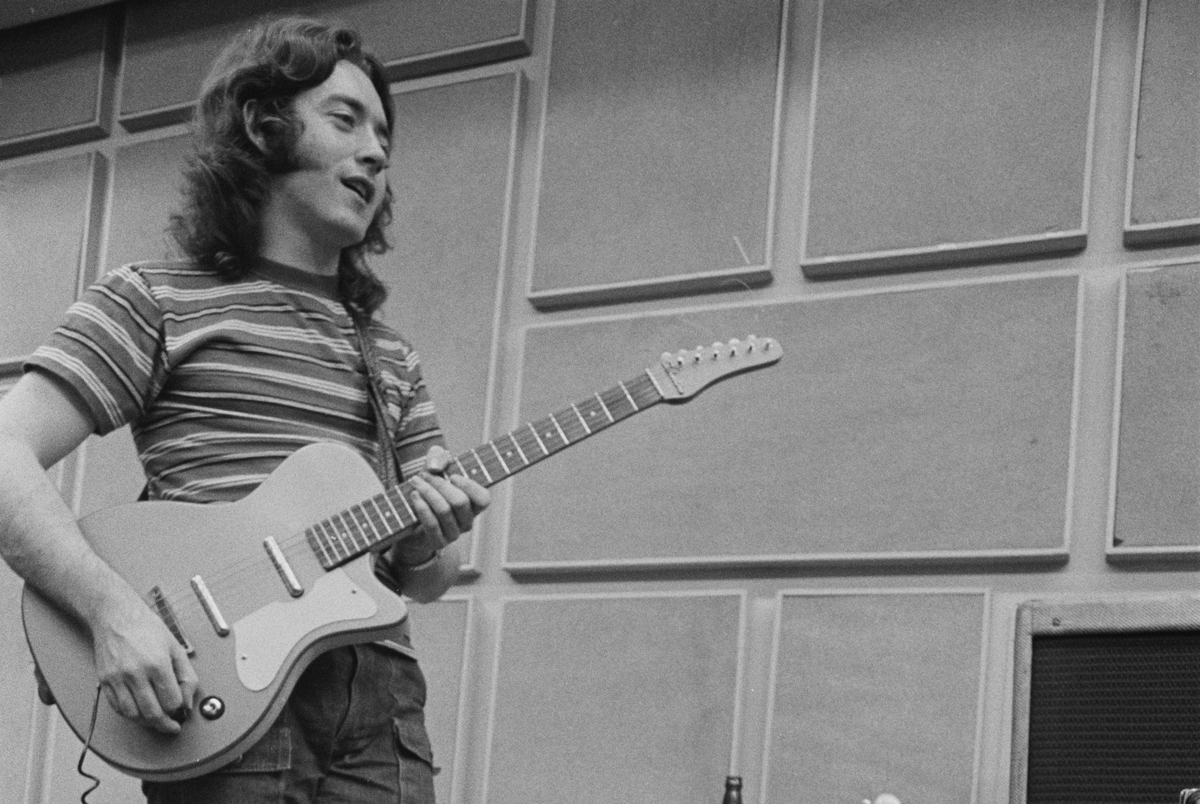
The mighty mail-order firm Sears, Roebuck was an important source of affordable guitars in the '50s and '60s.
Danelectro, Harmony, Kay and others supplied instruments to Sears bearing the company’s own Silvertone brand, and, by the late-'50s, Sears was offering a line of models such as this Silvertone 1323, derived from a Dano U2.
Thousands of would-be American guitarists started out with their cheap, effective Silvertones thanks to the Danelectro factory in New Jersey.
20. 1958 Gibson ES-335
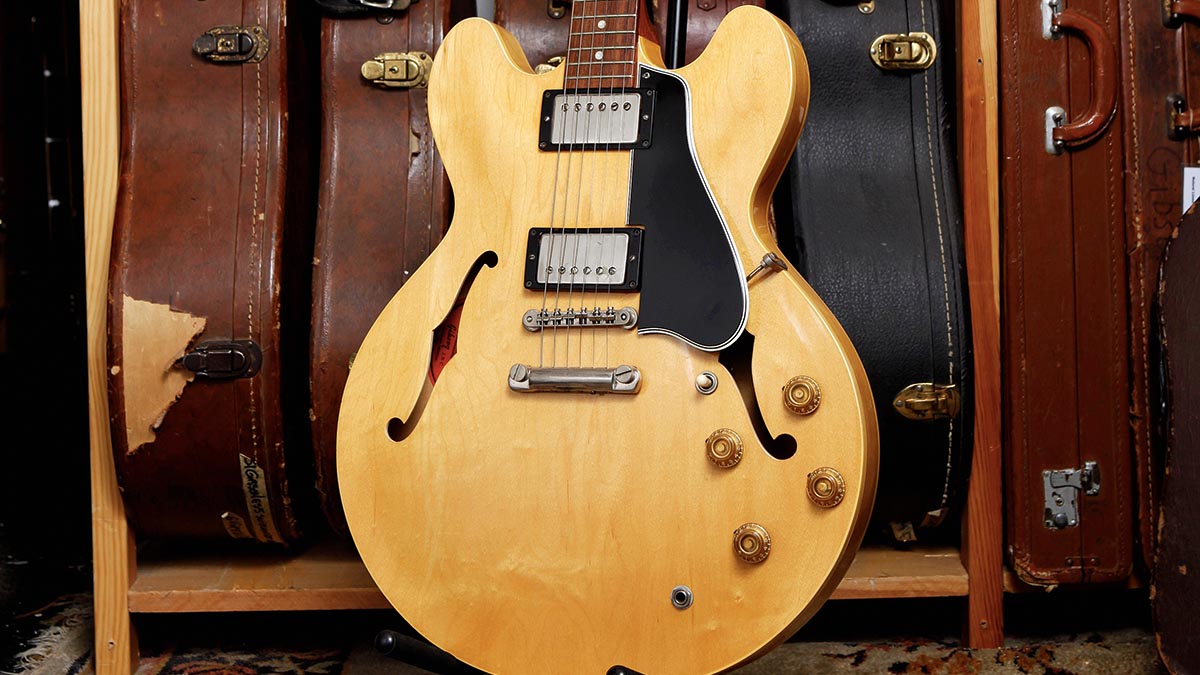
The now-classic 335 was Gibson’s most revolutionary electric guitar. It had two radical body features: double cutaways, and a semi-solid structure. The cutaways made it easier to reach higher frets, while a solid maple block inside the body tamed feedback and combined solidbody-like sustain with a hollowbody’s woody warmth.
The result was a comfortable electric for the modern player who wanted to explore traditional tones at elevated volume levels.
21. 1958 Fender Jazzmaster
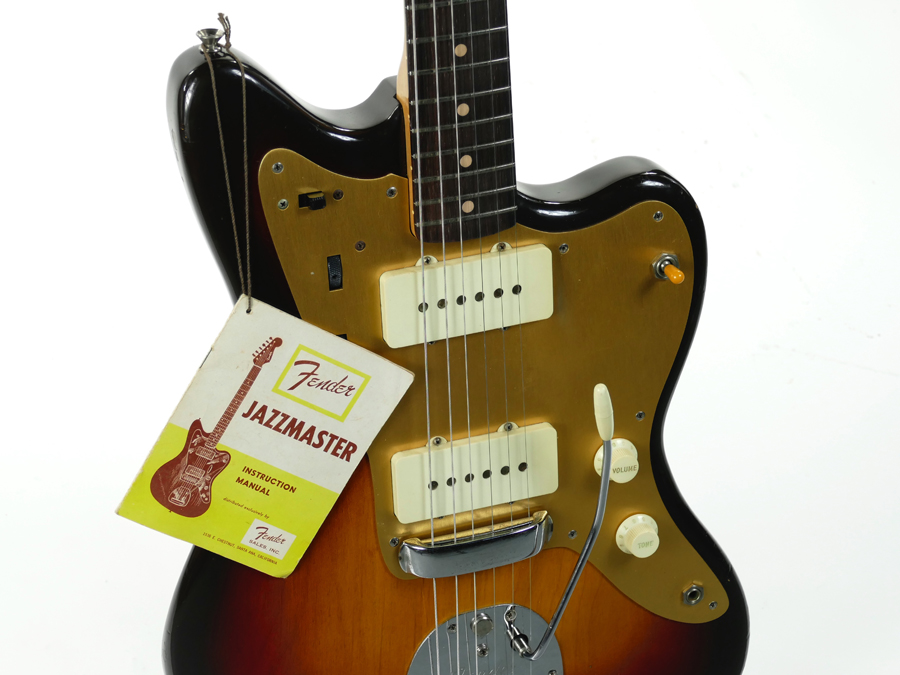
Following the success of the Telecaster, Esquire and Stratocaster, as well as the Precision Bass and Jazz Bass, in 1958 Fender introduced a further solidbody guitar – the high-end Jazzmaster.
It had an enlarged headstock, a body with Fender’s new offset-waist design, the first Fender appearance of a separate rosewood fingerboard, two new-style single-coil pickups, a floating vibrato bridge, and an array of controls including a switch to select between preset rhythm and lead settings.
22. John Lennon’s 1958 Rickenbacker 325
The Beatles have been important to Rickenbacker, and this is where that connection began. John Lennon bought this, his first American guitar, when his band played a residency in Hamburg, Germany, in 1960.
After a long life, today it has a non-standard pickguard and knobs, and the finish restored to original natural. Lennon played this and a later 325 throughout most of the band’s life on stage and in the studio.
23. Dave Davies’s 1958 Gibson Flying V
In 1958, Gibson introduced the Flying V and Explorer models to almost universal disapproval, and only 98 Vs were made before production ceased in ’59.
When Dave Davies happened on an original V during a Kinks US tour in 1965, he went on to provide the first glimpse of this rare instrument for many fellow guitarists. It became clear to players what a great guitar this was, and showed makers that a solidbody could be virtually any shape.
24. Bo Diddley’s 1958 Gretsch custom rectangular guitar
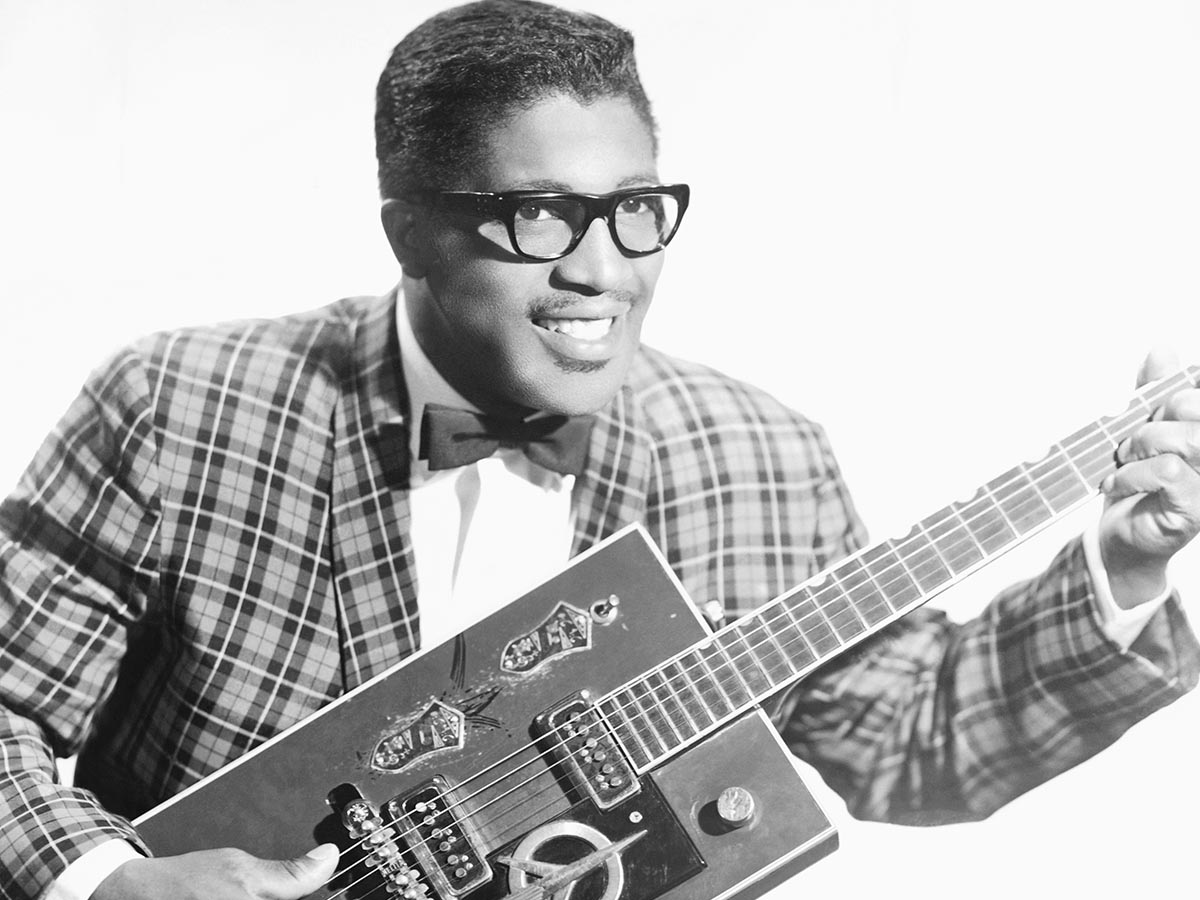
Rock ’n’ roll hero Bo Diddley teamed up with Gretsch to create a series of unusually shaped guitars, including this flat-sided beast from 1958. Billboard magazine noted that Gretsch “has made a special custom-built square guitar for Bo Diddley – this is a strong artist who would probably sound great even with glockenspiel accompaniment”.
Here was early and very public evidence that some players no longer required instruments that matched the conventional template.
25. Eric Clapton’s c.1959 Gibson Les Paul Standard ‘Beano’
This guitar, missing since stolen in 1966, is a rare example of an influential instrument that no-one has seen for a very long time indeed. Clapton bought the sunburst Les Paul in London in ’65, using it for John Mayall’s Blues Breakers album.
The cover had EC reading a copy of the Beano comic – hence the guitar’s nickname – and sunburst Standards rose dramatically in popularity and value as Clapton and others demonstrated their musical worth.
Read more: The strange case of the missing Beano: where is Eric Clapton’s stolen Les Paul?
26. George Harrison’s 1963 Rickenbacker 360/12
Rickenbacker models became the electric 12-strings of choice during a mid-60s trend for the 12’s big chiming sound, prompted by George Harrison.
Rickenbacker gave him this guitar – actually an early prototype – during the group’s first American tour early in 1964, and he used this and a second gifted Rickenbacker on many Beatle live shows and recordings, including A Hard Day’s Night and Ticket To Ride.
27. Johnny Winter’s 1963 Gibson Firebird V
With Fenders popular, Gibson looked for a competing design, landing with the Firebird line, new for 1963 and devised by car designer Ray Dietrich. Firebirds had a neck-through-body design and a similar look to Fender’s offset style, which gained these first Firebirds the ‘reverse’ nickname.
The Texan bluesman Johnny Winter favoured a sunburst V, which he bought around 1970 for $225, and he showed just what it could do, especially when he took a slide to it.
28. 1966 Vox Guitar Organ

The Guitar Organ – devised by Dick Denney, who designed many Vox amplifiers – had frets with contacts connected to the innards of a Vox organ in the body. The idea here was to create organ sounds or guitar sounds, individually or simultaneously.
It was a difficult instrument to play, not least because of a neck wider at the nut than the body, and did not last long, but it provided an early suggestion that a guitar might be made to sound like a keyboard.
29. Jack White’s c.1965 Airline 7283
Alongside Sears, Roebuck, the other big name in US mail-order was Montgomery Ward. Like Sears, it bought in instruments for its house brand, Airline, and served many a fledgling guitarist.
Valco in Chicago built a series of models for Ward, some of which used moulded-fibreglass bodies, like some similar Valco-made National and Supro guitars. When Jack White later used an Airline for his work in The White Stripes, Airline became a key name in retro-land.
30. Kurt Cobain’s 1965 Fender Jaguar
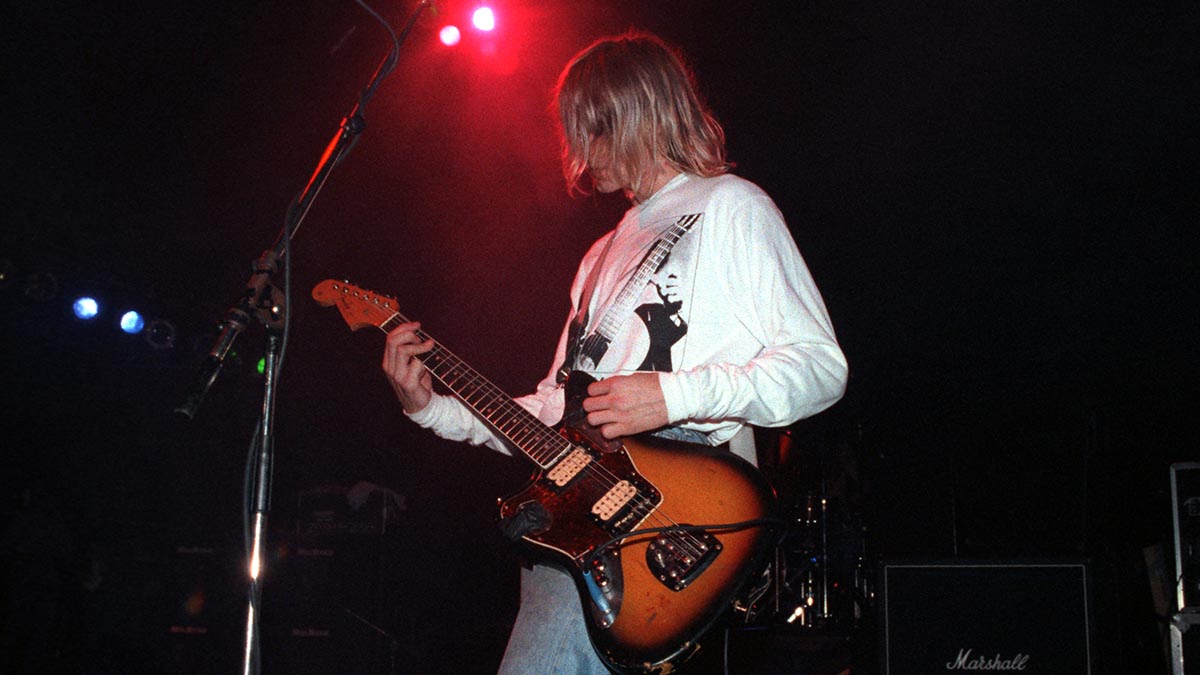
Kurt Cobain’s favoured guitar for Nevermind-era Nirvana was a left-handed Jaguar. It had some odd features for a ’65, various aftermarket mods, including DiMarzio pickups and an extra volume knob, and it soon gained a taped-off toggle area.
During the 90s and beyond, Cobain’s love of offset Fenders did much to repopularise these models, which had gone in and (more often) out of fashion through the years since their introduction.
31. Jimmie Webster’s 1966 Gretsch White Falcon Super Project-O-Sonic 6137
The White Falcon was a spectacular gleaming object that appeared in 1955, designed by Gretsch’s chief ideas man, Jimmie Webster.
This double-cutaway guitar was owned by Webster himself and typifies Gretsch mid-'60s style, with double mute switches and pads, telescopic vibrato arm, multiple stereo controls, Space Control bridge, T-Zone slanted frets, thumbnail markers, two Filter’Trons, and, of course, That Great Gretsch Sound. It surely qualifies as a gadgeteer’s guide to extreme gadget guitars.
32. 1968 Micro-Frets The Orbiter
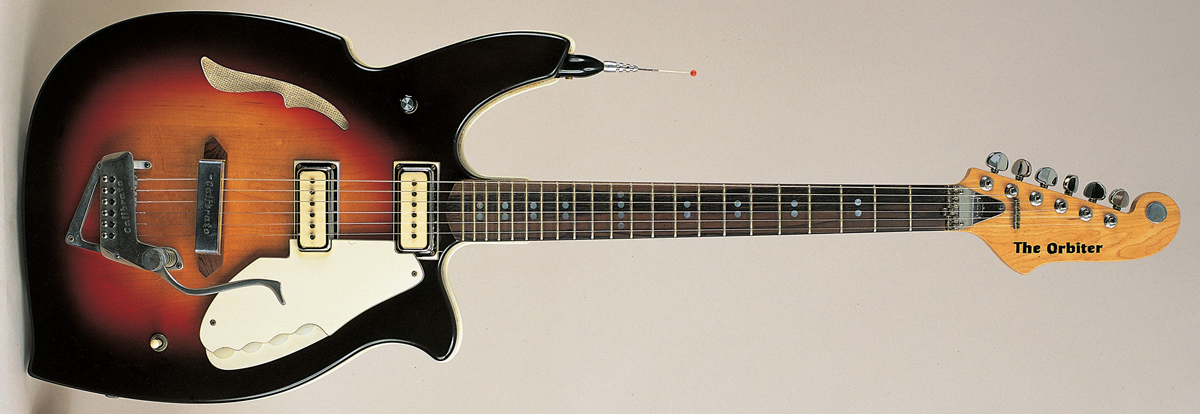
This innovative instrument was probably the first wireless guitar, well ahead of its time. The onboard FM transmitter’s antenna sat on the upper horn of the body and a receiver plugged into an amp.
The idea came to Ralph Jones at Micro-Frets in Maryland from the growing popularity of wireless-controlled garage doors. Micro-Frets guitars had an unusual side-join body construction, and some had a clever intonated nut, but the brand was gone by the mid-70s.
33. 1969 Ampeg Dan Armstrong See-Through
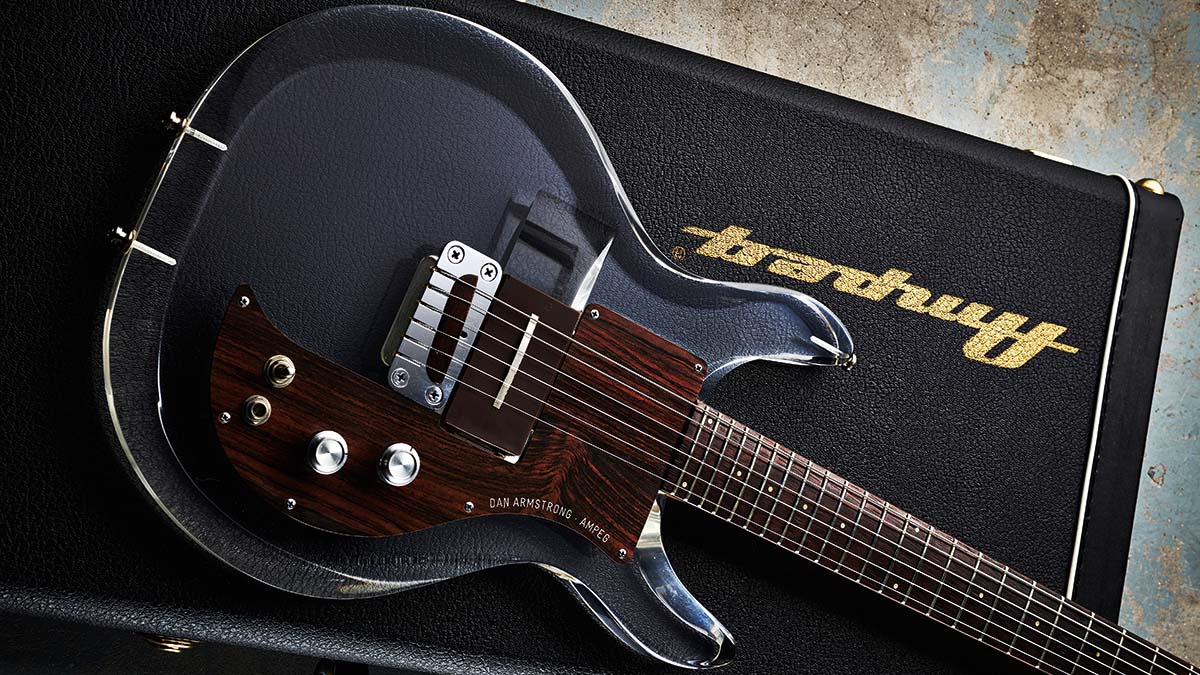
Ampeg, better known for amps, hired Dan Armstrong to design this guitar, which had a body carved from a block of clear plastic, as much to grab attention as to exploit any sonic potential the material might have.
Another novel idea was the six slide-in/slide-out pickups – Rock, Country or Jazz in Treble or Bass varieties. The See-Through guitar lasted little more than a year in production, brought down by conservative guitarists (Keef excepted) and expensive production.
34. Jimmy Page’s 1971 Gibson EDS-1275
Jimmy Page ordered a doubleneck from Gibson in the early 70s so that he could play both the six-string and the 12-string parts of Stairway To Heaven on stage without changing guitars.
It prompted a surge of prog-tastic interest in such twin-pronged beasts from the likes of John McLaughlin (Mahavishnu Orchestra), Steve Howe (Yes) and Alex Lifeson (Rush). Gibson spotted the trend, too, and reissued its EDS-1275 Double 12 in 1975.
35. Angus Young’s c.1971 Gibson SG Standard
The SG was a fine piece of sculptural guitar design when Gibson introduced it in 1961, a modernistic amalgam of bevels and points much studied by other makers. Angus Young showed how one model type could sustain a guitarist through his whole career, acquiring his first SG in Australia in the early 70s.
In addition to his SG Standard, also notable is Angus’s iconic c.1970 SG Custom, used throughout the Back In Black tour, which had its middle pickup removed and pickguard replaced.
36. 1971 Ovation Electric Legend 1617
In 1971, Charles H Kaman’s Ovation brand popularised the integrated amplified acoustic, an idea that caught on quickly among many other makers. Ovation had already raised eyebrows among the conservative world of flat-tops with its ‘Lyrachord’ composite fibreglass bowl-shaped backs.
The brand’s electro-acoustics were a more important development, using piezo pickups mounted under the bridge saddles linked to an onboard preamp to provide an amplified acoustic sound, with controls on the body’s side.
37. 1976 Fender Telecaster Deluxe

Influenced by a popular mod that added a neck humbucker to a Tele, Fender put twin humbuckers on the existing Thinline in ’71 and the Deluxe (’73), and a neck ’bucker on the Custom (’72).
Fender said of the two-’bucker models: “The humbucking pickups not only help eliminate feedback, they also add a gutty midrange and bass sound.” It was about as close as Fender would come officially to say: “This Fender is like a Gibson.”
38. 1976 BC Rich Mockingbird
On the road to the pointiest of pointy guitars, BC Rich in general and the Mockingbird in particular drew the eye of many a metallic musician. It wasn’t only its dangerous curves.
Bernardo Rico’s guitars often had neck-through construction, and the controls provided a knob-twiddler’s paradise. The ’76 Mockingbird has a volume per pickup and a master tone, a regular three-way toggle, a coil-tap per pickup, a phase switch and a five-way chickenhead varitone filter. Enough?
39. Edward Van Halen’s c.1977 Frankenstrat
Ed’s guitars paved the way for '80s SuperStrats as a result of his fun with DIY. His Frankenstrats began around 1977 with the black-and-white guitar seen on the cover of the first Van Halen album.
He took a Strat-style body and neck from Charvel, a PAF humbucker from a 335, slanted at the bridge, glued in some jumbo Gibson frets, screwed on a Strat vibrato, and fitted a single volume control. Ready to rock.
40. 1981 Gibson Chet Atkins CEC
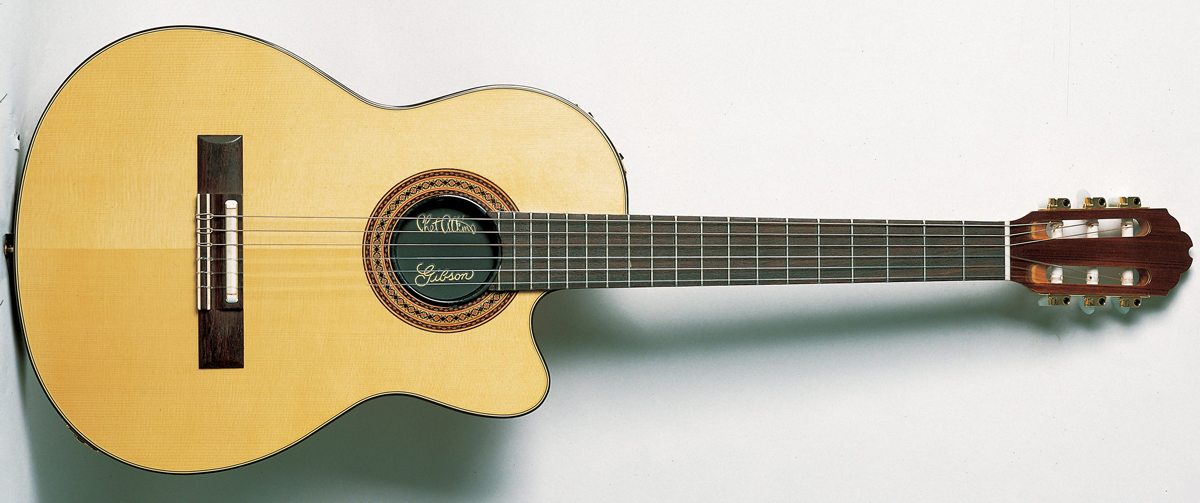
Amplifying a nylon-string guitar for stage use took a useful step when Gibson collaborated with Chet Atkins to design the CEC electro-acoustic classical. Despite his reputation as an electric player, Atkins was, by the 80s, mostly playing nylon-string classical-style flat-tops, and he wanted a practical electric model.
His idea for Gibson used a semi-solid body and a piezo bridge pickup, the result mostly looking and feeling something like a classical guitar but louder.
41. 1982 Fender Squier Series Telecaster ’52
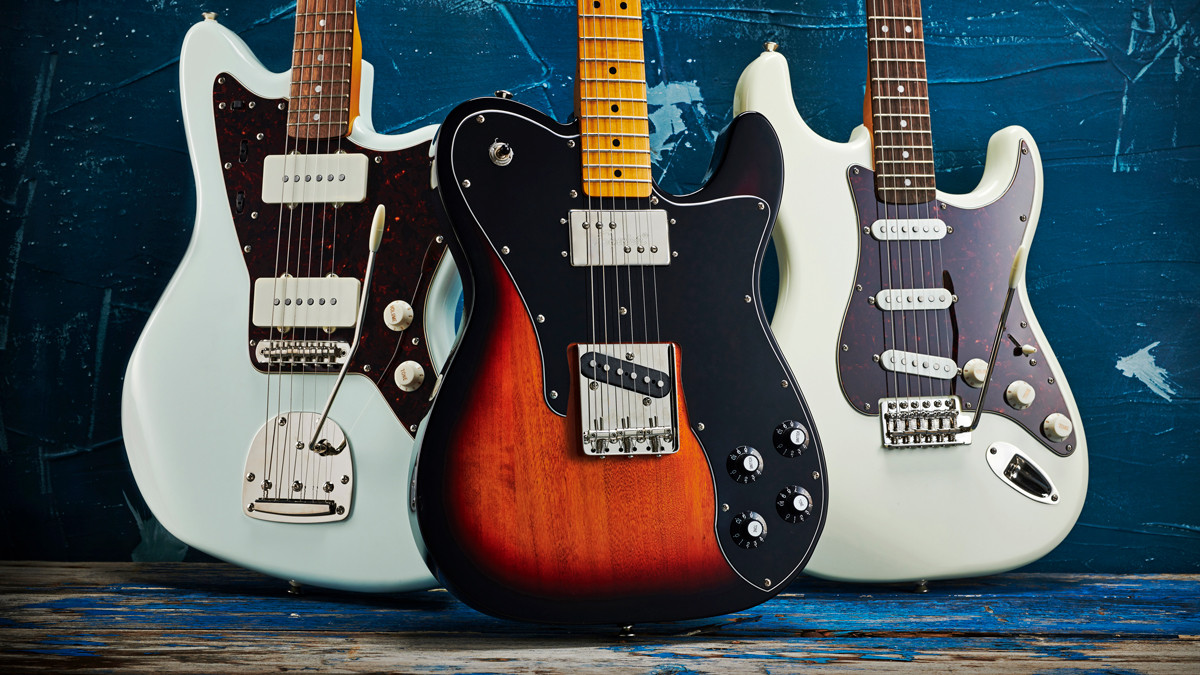
Fender introduced vintage reissues with a trio of models in 1982 that recalled '50s features, at first made at the Fujigen factory in Japan. The company’s European agent requested budget-price versions to compete with the multitude of Fender copies, which, in its view, were damaging the market.
The result was the Squier, which has since expanded greatly to a strong second-tier brand for Fender, and the spur for many other makers to develop quality overseas manufacturing.
42. 1983 Jackson Randy Rhoads
Randy Rhoads was playing with Ozzy Osbourne in 1980 when he met Grover Jackson, and the two designed a custom guitar based on a classic Flying V. A little later they collaborated again on a radical variant with a notably offset body style, which established the ‘extreme V’ style.
Following Rhoads’s tragic death in ’82, the first Jackson-brand production instrument, the Randy Rhoads model, appeared the following year.
43. 1983 Roland G-707
Guitar synths started to appear in the mid-70s, promoting the idea that a guitar rather than a keyboard could control a synthesizer. Roland became the busiest activist, developing models from 1977 with separate guitar (“controller” in Roland-speak) and synthesizer unit.
The most unusual was the G-707/GR-700, introduced in 1983, and the 707 guitar/controller was quickly nicknamed ‘The Coat Hanger’ for its look. But still the guitar-synth remained a specialist item.
44. 1983 Kramer Pacer
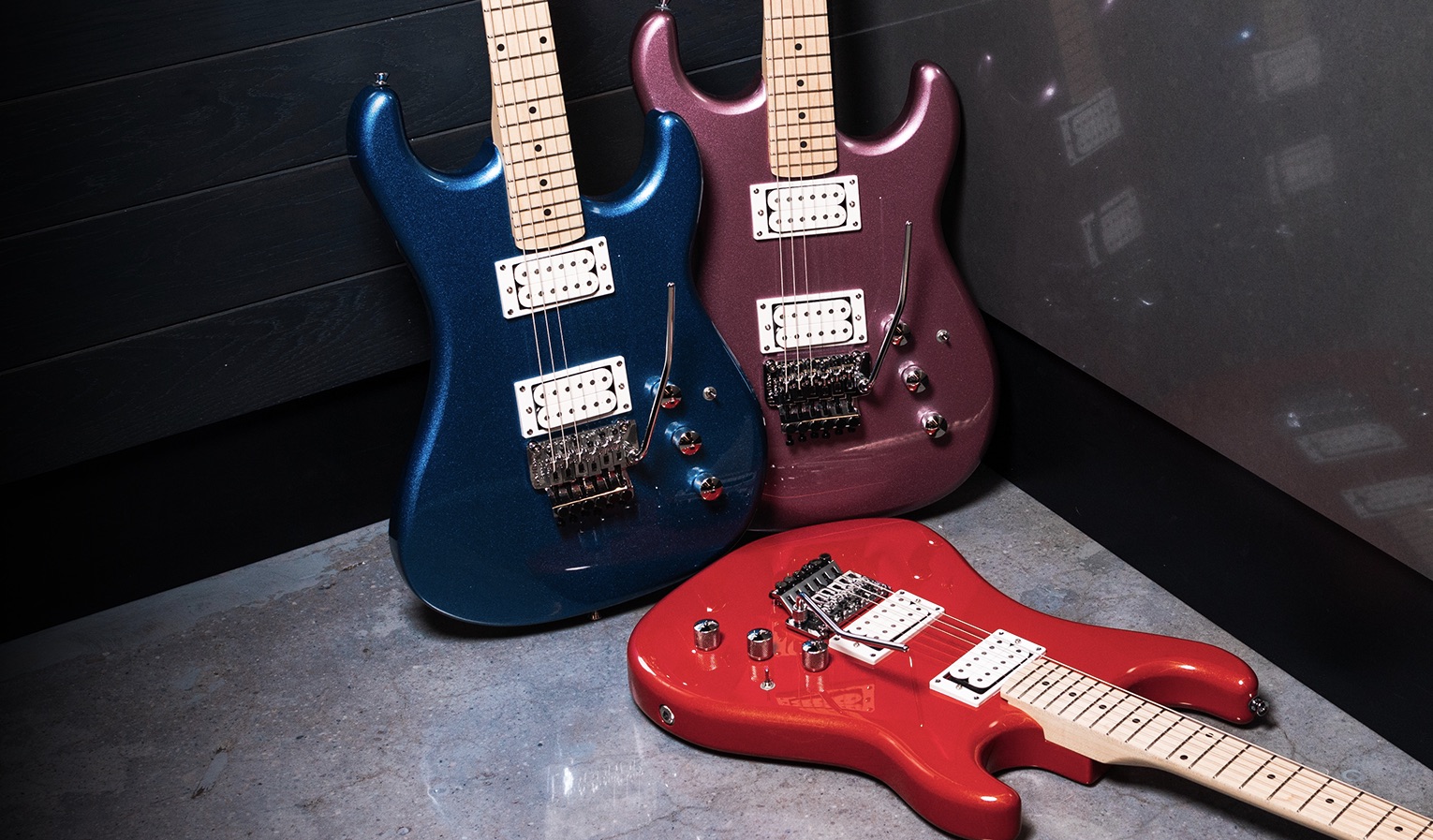
Kramer was the most successful electric brand of the '80s, leading the push to ‘SuperStrat’-heaven with a line of simple, effective shred machines. The brand also helped establish the Floyd Rose locking vibrato, which quickly became the metal guitarist’s vibrato system of choice.
Other locking systems were developed at the time, by Rockinger, Kahler, Ibanez and others, but the Floyd, especially with the addition of fine-tuners at the bridge, was top of the divebombers’ tree.
45. 1985 PRS Custom
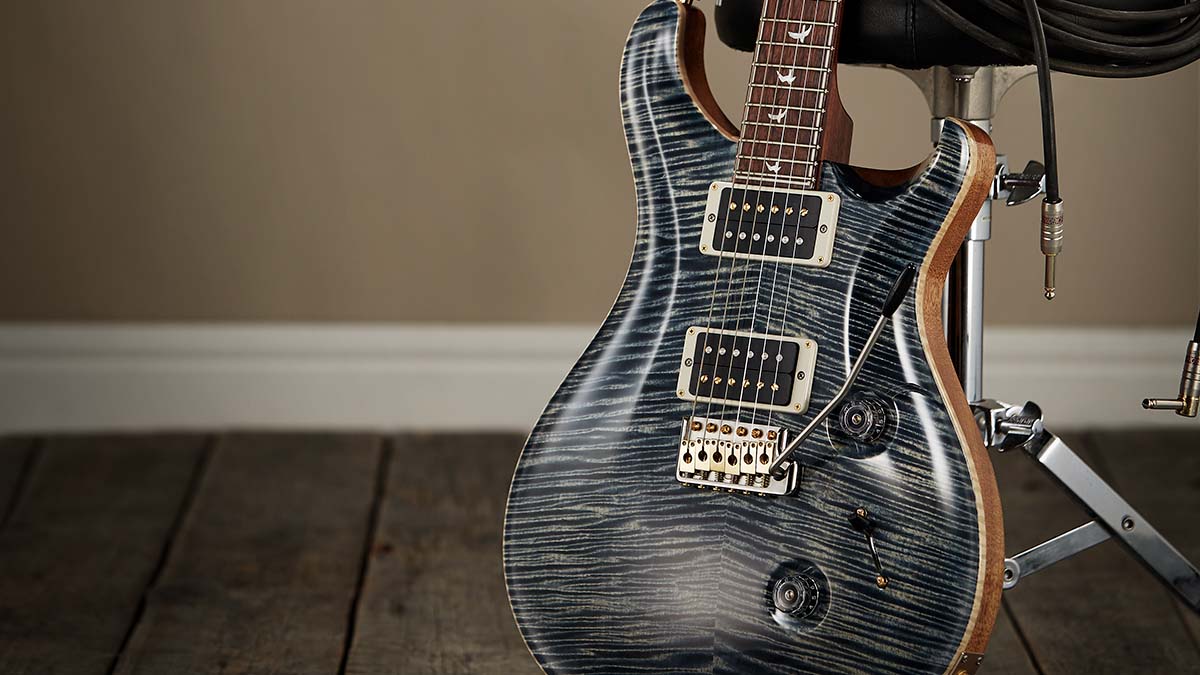
Paul Reed Smith was among several makers in the 80s who wanted to combine the best of Gibson and Fender. An early result for his new-for-1985 PRS company was the Custom.
Its mahogany-maple construction and fancy timber recalled 50s Les Pauls, while the through-body stringing and simple vibrato came from the Fender rulebook. PRS has ranged far and wide since, but this was the model that first put it on the map.
46. Steve Vai’s 1987 Ibanez JEM777LG
Ibanez made a breakthrough among extreme rock players in 1987 with the distinctive Steve Vai JEM model. It had colourful HSH DiMarzios, a Monkey Grip body handle, Disappearing Pyramid inlays, a thin 24-fret neck (the top four frets scalloped), and Lion’s Claw cutouts behind the Edge locking vibrato for pull-ups.
It formed the basis for Ibanez’s highly successful RG series of ‘SuperStrats’, while many JEM variations followed alongside Vai’s Universe seven-strings.
47. 1991 Charvel Surfcaster
An early sign of the '90s retro fashion came with Charvel’s Surfcaster. Makers looked back for features that made past instruments distinctive, borrowing them to give new models a modishly vintage vibe.
The Surfcaster mixed old influences – lipstick pickups (Danelectro), slash soundhole and triangle markers (Rickenbacker) and a pearly pickguard (Fender). Many other electric brands took note of this early indication that retro could not only look good but also sound good and attract players.
48. 1993 Parker Fly
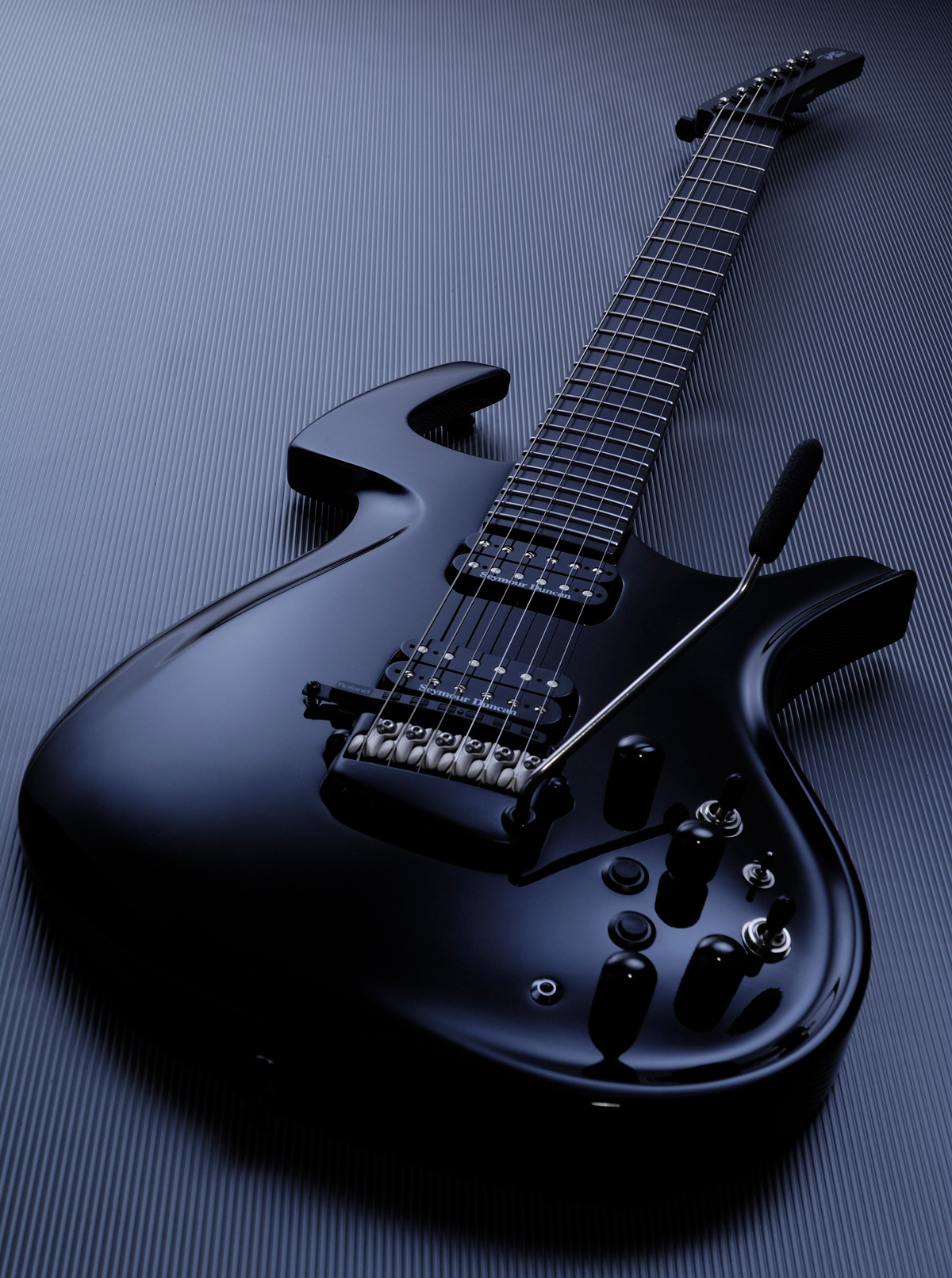
Ken Parker and Larry Fishman cut a unique swathe through 90s electrics with the hybrid Parker Fly models. Their radical construction had ultra-thin wooden bodies strengthened by a composite carbon and epoxy material forming an ‘external skeleton’ around the wood.
Necks were similarly made, and the guitars combined sounds from piezos and magnetic pickups. It was an intriguing but short-lived look at what an electric guitar could be.
49. 1994 Martin Backpacker

Upon its 90s launch, Martin’s Backpacker was an inexpensive compact guitar with a narrow body about nine inches at its widest and a 24-inch scale length, the whole thing around 3ft long and weighing a touch over 5lb.
Its take-anywhere vibe was demonstrated in spectacular fashion when astronaut Pierre J Thuot took one on a space-shuttle mission in March ’94, and since then it seems as if every acoustic maker has offered a travel model.
50. 1995 Fender Relic Telecaster
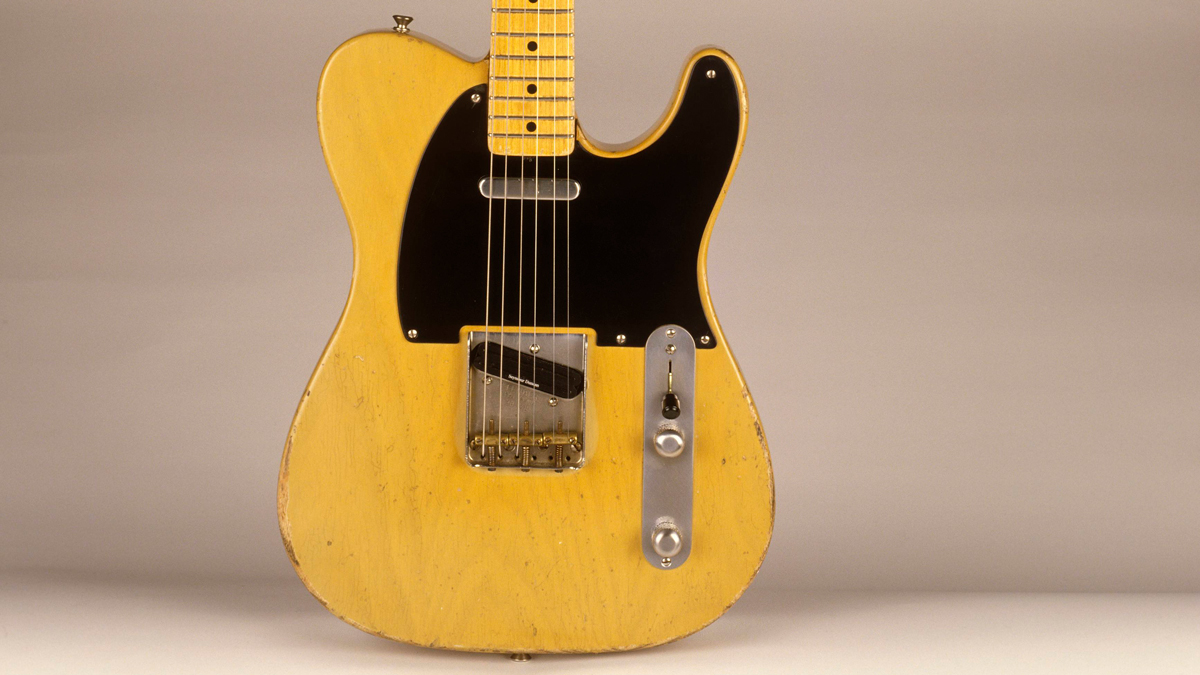
Fender popularised the idea of the relic’d guitar, starting in 1995 when Vince Cunetto began ageing the bodies, necks and parts Fender sent to his Missouri workshop.
Four years later, the work moved to Fender’s Custom Shop. It wasn’t a new idea – repairers have always restored old guitars. Now, though, a new-oldie could take away the fear of damaging a collectable, and modern relics were soon to be seen in many other makers’ freshly aged inventories.
“It holds its own purely as a playable guitar. It’s really cool for the traveling musician – you can bring it on a flight and it fits beneath the seat”: Why Steve Stevens put his name to a foldable guitar
“Finely tuned instruments with effortless playability and one of the best vibratos there is”: PRS Standard 24 Satin and S2 Standard 24 Satin review






















